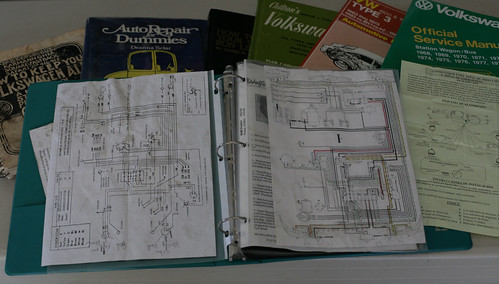
I don't know if kit cars come with instructions. I suppose they must. If there ever were instructions for the car that I bought, they had long since been lost by the time it arrived in my back yard. There were a few things I already knew how to do, such as remove and install the engine, fix the braking system, replace the worn parts in the suspension systems, and, of course, sand away the rust and repaint the bare metal surfaces. Those are all important things to know, and I was glad I had learned them over the years, but I had never started a project that was quite this much of a blank canvas.
The first thing to do was to make a list of what it would take to make a car out of this thing I had bought. What are the components of a safe, dependable automobile? There are some systems that you just can't do without: brakes, suspension and steering, fuel, oil and electrical. In addition, you'll need something to sit on while you drive and a windshield to keep the bugs out of your teeth. There are some items your family car came with that you can do without when you're building a simple dune buggy: heater, air conditioner, radio, windows, carpet, cup holders, interior lights, and a glove box. After a quick evaluation of what I had to work with, I made my list: engine, carburetor, distributor, ignition wires, oil cooler, engine sheet metal, generator, voltage regulator, fuse box, transaxle, rear brake drums, shock absorbers, tires, wheels, speedometer, battery, headlights, tail lights, turn signals, brake master cylinder, wheel cylinders, brake shoes, brake springs, emergency brake cables, clutch cable, accelerator cable, hoses, and wires, lots and lots of wires.
The next step was to get the basic components ordered, so it was off to B.C.E. with my list. I ordered parts, got lots of advice and went back to sanding and painting. I also sent the wheels off to be powder coated. Since the body of the car was yellow, I thought black wheels would contrast nicely and make it look at bit less "cute" and a little more aggressive. Plus, the powder coating is very, very hard, which means it resists scratches and keeps the underlying metal part from rusting, an important consideration for a car that was destined to spend most of it's life outdoors in all sorts of weather. The wheels that came with the car seemed to be sound, so those are the ones I sent to the powder coater.
I kept thinking that this project was just too easy. All I had to do was wait for the parts to come in and then just put it together. I didn't realize then, how much I had yet to learn.




No comments:
Post a Comment